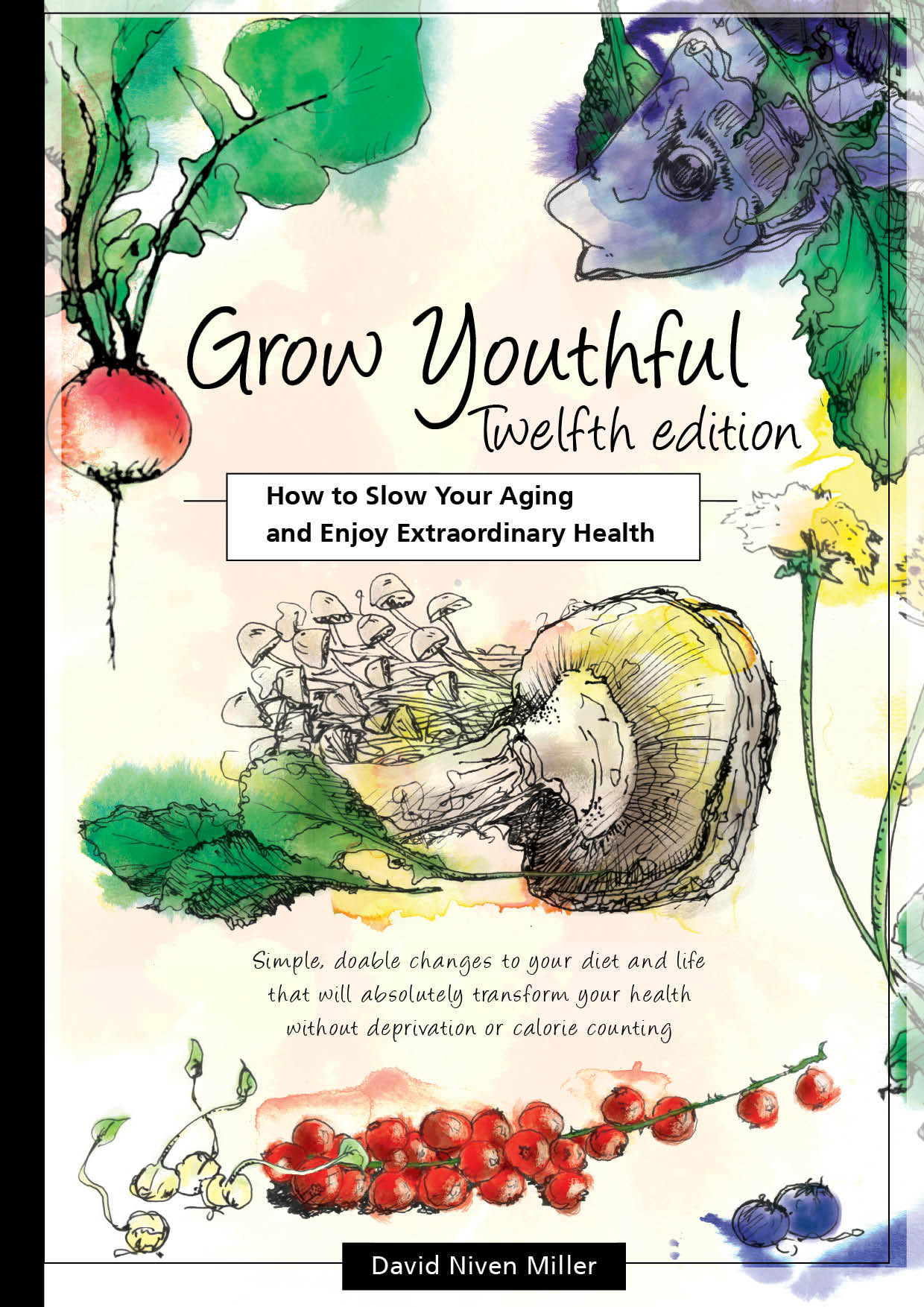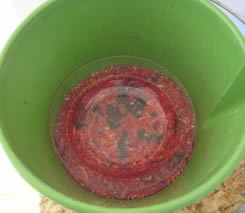
Sauerkraut
What is sauerkraut?
Benefits of sauerkraut
Sauerkraut must not be pasteurised
Risks with cruciferous vegetables
SAUERKRAUT RECIPE
Yeasts and moulds
Buy fermentation accessories (Australia only)
Buy vegetable fermentation equipment (Australia only)
References
What is sauerkraut?
The daily use of living, fermented, acidic foods prolong life and are a secret to ongoing good health. Fermented vegetables and milk are rich in lactic acid, which inhibits the bacteria that cause putrefaction. Along with many other organic acids, lactic acid also greatly assists people with weak digestive systems (ie most people who are over 40). (3, 4)
Sauerkraut combines the health benefits of cabbage and other cruciferous vegetables with the probiotic advantages of the fermentation process. Cabbage and other vegetables turn into a super-probiotic when pickled.
Humans have been eating pickled vegetables for thousands of years. As people first moved into the higher latitudes they needed to store food for the sparse, snow-covered winter months. Sauerkraut was a means of preserving cabbage and other vegetables for easy consumption throughout the winter. Historical evidence suggests that workers on the Great Wall of China ate a version of pickled cabbage 2,000 years ago.
Lacto-fermented vegetables (sauerkraut, kimchee) store virtually all the benefits of fresh vegetables for long periods. Captain James Cook always took a store of sauerkraut on his sea voyages, since experience had taught him it prevented scurvy among his crew.
Benefits of Sauerkraut
Sauerkraut provides a high-density source of a wide range of beneficial live lactic acid bacteria which assist in the digestive process, heart and cardiovascular health (3, 4), produce a variety of vitamins and other nutrients, and keep harmful micro-organisms at bay. A single serving of genuine raw sauerkraut gives your body a bigger health boost than any of the expensive probiotic drinks and supplements sold in stores.
Cruciferous vegetables (also known as Brassicaceae or Brassicas) include broccoli, Brussels sprouts, cabbage, cauliflower, collard, cress, horseradish, kale, kohlrabi, mustard greens, radish, rutabagas, turnip and watercress.
Cabbage, Brussels sprouts and other brassicas offer a host of health benefits. They are high in vitamins A and C. Cabbage provides a rich source of antioxidants. Studies have shown that the cruciferous vegetables can help improve cholesterol levels; have anti-inflammatory properties; and help prevent and combat many cancers. (1, 2)
A phytonutrient in these vegetables named glucosinolate significantly enhances your liver's detoxification ability. According to one study (1), eating these foods every day will halve your risk of getting cancer.
Some of the phytonutrients in this family seem to be able to protect mucous membranes, especially in the lungs and digestive tract. They are effective guardians against cancer, ulcers and infections in the digestive tract.
Sauerkraut is one of the richest food sources of vitamin K2, which assists the body in putting calcium in bones and preventing it accumulating elsewhere, such as arterial plaque, bone spurs, kidney and liver stones, and painful deposits in joints. It helps protect against osteoporosis.
Sauerkraut must not be pasteurised
Most sauerkraut sold in supermarkets and shops is pasteurised. The beneficial bacteria and other organisms have been destroyed to give it a long shelf life, and so there is no risk of the jar exploding from pressure build-up. To gain the benefits from sauerkraut, it MUST be made the traditional way.
Risks with cruciferous vegetables
The main disadvantage of cruciferous vegetables is that they contain high levels of goitrogens. Goitrogens are substances that prevent the uptake of iodine by the thyroid gland, and iodine uptake in the rest of the body. Their primary effect is suppressed thyroid function. Our exposure to numerous goitrogens in the environment and in our food is much higher than 50 or more years ago.
Kale is high in oxalic acid and other indigestibles.
Fermenting does not reduce the level of goitrogens that cruciferous vegetables contain.
Cooking destroys most of the goitrogens in cruciferous vegetables. For example, steaming reduces the goitrogens in cabbage by about two thirds, and boiling cabbage for 30 minutes reduces the goitrogens by nearly 90%. However, you must use RAW INGREDIENTS to make sauerkraut.
Fermented foods such as sauerkraut are wonderful in that they provide probiotics and bio-available nutrients. However, consuming large amounts of sauerkraut could actually be harmful to the function of your thyroid, especially if your thyroid is already compromised. I would advise you to monitor how you feel on a diet high in crucifer vegetables. It is best to consume fermented cruciferous vegetables as condiments, not as a large part of your diet.
Sauerkraut is a wonderful, healthy food when consumed with restraint. To counteract the goitrogens in the cabbage, I add iodine-rich seaweed to my sauerkraut. I also include dill and juniper berries in my sauerkraut as they add a perfect complimentary flavour to the finished product.

SAUERKRAUT RECIPE
Here is how to make sauerkraut:
Ingredients
2 large cabbages. Reserve 3 - 4 large leaves - enough to cover the surface of the brewing container
2 large onions
Optionally, other vegetables in season. I have also used hot peppers, carrots, beets, beetroot, caraway seeds, a wide variety of fresh herbs, radish, curry powder, ginger and garlic, all with great success
2 teaspoons of sea salt. Use more salt if you are not adding the whey below, less if you have a good raw milk kefir whey. The salt helps promote the lactic acid bacteria in competition with bad bacteria
1 cup filtered water. Use rejuvelac if available, otherwise filtered water
1 cup of liquid whey. If whey is not available, use 1 cup of lemon juice, or half a cup of vinegar, preferably apple-cider vinegar. White supermarket vinegar is a poor alternative. The clear liquid whey that forms as kefir or yogurt sours as it ages is by far the best starter, and will make a reliable and delicious sauerkraut by introducing plenty of lactic acid bacteria
2 Tbs juniper berries (optional)
2 Tbs seaweed such as wakame, kelp or dulse (optional)
Recipe
Shred the cabbage and other vegetables in a food processor. Put the shredded vegetables in a large container or bucket with the other ingredients. Pound them with a pestle or wooden mallet for 10 minutes - long enough to release the juices.
Press the mash down. The liquids should just about cover the top of the mash. Put a large plate into the bucket that fits nicely and seals the top, and a heavy weight on top of it. Within a few hours, liquids should cover the top of the shredded mixture (if it did not cover to start with). If there is not enough cabbage juice, add cold filtered water with whey / lemon juice / vinegar to cover.
Leave to ferment at room temperature for 3 - 5 days. Within 1 day the smell should start to change, and within 3 days the mixture should have a delicious aroma. After 2 - 3 days of lacto-fermentation, vegetables start to soften and some of their components break down. As lactic acid-producing bacteria proliferate, the food becomes more acidic and easily digestible. Micronutrients such as choline are formed, the entire medium is preserved, and new flavours and aromas develop.
Transfer to capped jars. Leave 2 - 3 cm / 1 inch at the top as they can bubble and leak. However, try not to expose it too much to the air, as making sauerkraut is an anaerobic process.
Sauerkraut may need to be stored in the refrigerator if you live in a hot climate, but most refrigerators are too cold to allow it to mature properly. The ideal storage is about the same as for a fine bottle of wine. Sauerkraut needs at least six months to fully mature, depending on what it is made from; the best sauerkraut I have tasted was eighteen months old.
Yeasts and moulds
Kahm yeast. Sometimes a white, velvety or powdery looking yeast or scum develops on the surface. It is not harmful, but does not improve the flavour. If it develops, skim it off the surface of the liquid. Discard any solid matter that has it. As usual, your senses are the test - if it smells and tastes OK, it probably is.
Kahm yeast is likely to develop if:
- Your brew is insufficiently acid, especially when you start it.
- There is not enough salt.
- It is too warm.
- Over exposure to the air.
- From poor hygiene.
If black or blue mould forms, throw the brew away. It usually smells horrible, and you wouldn't want to eat it anyway. Mould forms for the above reasons, and also because there was not enough liquid - the solid matter is left exposed to the air and light, especially during the first few days before sufficient acidity builds up.
Only normal kitchen hygiene is required.
References
1. Adeline Seow, Jian-Min Yuan, Can-Lan Sun, David Van Den Berg, Hin-Peng Lee, Mimi C.Yu.
Dietary isothiocyanates, glutathione S-transferase polymorphisms and colorectal cancer risk in the Singapore Chinese
Health Study.
Carcinogenesis vol.23 no.12 pp.2055-2061, 2002.
2. Kristal A.R., Lampe J.W.
Cancer Prevention Research Program, Fred Hutchinson Cancer Research Center, Seattle, WA 98109.
Nutrition and Cancer [2002, 42(1):1-9].
3. Zhao X, Zhong X, Liu X, Wang X, Gao X.
Therapeutic and Improving Function of Lactobacilli in the Prevention and Treatment of Cardiovascular-Related Diseases: A Novel Perspective From Gut Microbiota.
Front Nutr. 7 June 2021;8:693412. doi: 10.3389/fnut.2021.693412. PMID: 34164427; PMCID: PMC8215129.
4. Wang G, Hao M, Liu Q, Jiang Y, Huang H, Yang G, Wang C.
Protective effect of recombinant Lactobacillus plantarum against H2O2-induced oxidative stress in HUVEC cells.
J Zhejiang Univ Sci B. 2021 May 15;22(5):348-365. doi: 10.1631/jzus.B2000441. PMID: 33973418; PMCID: PMC8110467.
